![]()
![]()
![]()
Use LEFT and RIGHT arrow keys to navigate between flashcards;
Use UP and DOWN arrow keys to flip the card;
H to show hint;
A reads text to speech;
28 Cards in this Set
- Front
- Back
- 3rd side (hint)
|
3 Major Types of Land
Descriptions |
1) Lots, Blocks, & Tracts
2) Metes & Bounds 3) U.S. Government Survey System |
|
|
|
Lot, Block, & Tract System
|
• dividing large parcels of land into smaller parcels aka: subdividing.
• by law all new subdivisions must b mapped or platted & recorded. • legal description r made: ex- All Lot 4 in Block A of Tract # 2025 in City of -- |
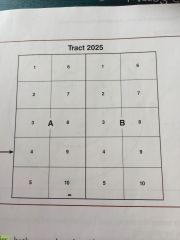
|
|
|
Metes & Bounds System
|
• property that is not covered by subdivision map or when property is so irregular in shape that it can't b described under section and township system.
• metes- measurement in length • bounds- boundaries (natural & artificial) • 3 important pts - start @ given point - follow from 1 pt to another - return to pt of beginning to enclose boundary lines. • ex: begin s line harbor, 200ft w of sw corner of harbor & 8th etc. |
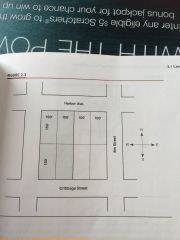
|
|
|
U.S. Government Section
|
• establishes monuments as points of beginning.
• intersected by 2 imaginary lines: 1 running east & west called base line. Another running north & south= meridian line |
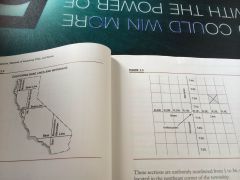
|
|
|
Township System
|
• Range lines= up & down to the meridian 6 miles intervals
• Township lines= side to side to the base line 6 miles intervals • Each township has 36 sq miles Ex: township 2 n, range 3 e, (T2N, R3E, SBBL & M( • Ea township is # 1-36 & ea section is 1 mile sq. is also 640 acres. • can b divided into smaller parcels: 1/4 of section =160 acres 1/4 of a 1/4 section= 40 acres 1/4 of a 1/4 of a 1/4 section =10 |
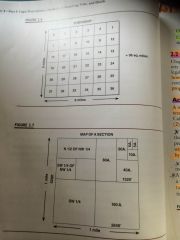
|
|
|
Measurements to Divide Townships/ Land
|
• 1 township section = 640 acres
- 1 mile= 5,280 ft or 320 rods - 1 rod= 16.5 ft - 1 acre= 43,560 sq ft - 1 sq acre= 208.71 ft - commercial acre= standard acre < land needed for st., sidewalks, & curbs |
|
|
|
5 Legal Ways of Acquiring Property
|
1) will
2) succession 3) accession 4) occupancy 5) transfer |
|
|
|
1)Types of Wills
|
1) Witness will - typewritten w/2 witnesses. 3 sign will. Attorney
2) Holographic will - hand written, signed, dated, w/no witnesses. 3) Statutory will- preprinted form approved by state, 2 witnesses. |
|
|
|
Special Terms
|
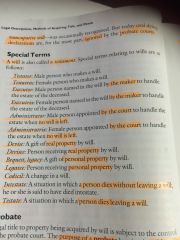
|
|
|
|
Probate
|
• purpose of probate= identify creditors & pay them off of deceased.
• once creditors r paid off the heirs get remaining prop. if any, all prop temporary possessed • estate can b sold during probate period (probate sale) |
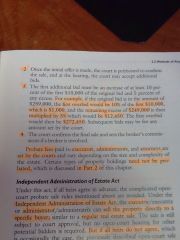
|
|
|
Independent Administration of Estate
Act |
• under this act all of the guidelines set by the court r avoided.
• executor/administrator can sell directly to specific buyer as a regular estate sale. |
|
|
|
2) Succession
|
• leaves no will / handing down of prop to another person.
• law dictates who gets the prop under the Law of Intestate Succession. • 2 categories: separate & community property |
|
|
|
Succession (Intestate Categories)
|
• when a person dies intestate
Prop of the deceased is divided into 2 categories: - separate prop: 1 spouse, 1 kid= 50/50 1 spouse, 2kids = 1/3 & 2/3 No spouse/kids= next of kin - community prop: All goes to surviving spouse, nothing to kids. |
|
|
|
3) Accession
|
A way to add prop to existing real estate = accession
1) Accretion- along waterways -soil deposit= alluvion (deposits) -reflection= water recedes & new prop is exposed 2) Avulsion- in storm, water tears away prop & adds to another prop (cultivate on other) 3) Fixtures- tenants attaches fixture w/out permission and then become landowners prop 4) Improvement Made in Error- attached to another land to improve prop. & didn't realize it wasn't there land |
|
|
|
4) Occupancy
|
Can b gained through: Abandonment & Adverse poss.
• Abandonment -tenant leaves early -rules regarding landlords rights re-renting apply • Adverse Possession- process to use/take someone else's prop - 1) u must use the land w/out hiding, everyone must see -2) hostile meaning w/out permission & no pymts -3) claim of right or color of title Claim of any prop or someone rents a prop to someone and has proof of fake lease (paper) not knowing it belonged to someone else. -4) possessed for 5yrs continuously & uninterrupted -5) paying taxes for 5yrs even if it's not ur prop. |
|
|
|
5) Transfer
|
Most common way to get prop is by transfer. 5 basic ways:
1) Private Grant: -owner voluntarily covey -ownership to another in a transaction is a Deed 2) Public Grant: -when the govt gives u a piece of land so u can make improvement to the land (homes,etc) they give u a patent (document) stating its ur land and ur gonna cont. making impr 3) Gift: -voluntary transfer of ur prop to a private person or organization w/out receiving compensation 4) Public Dedication: - prop is given to public body for streets, parks, bridges,etc and only valid if public accepts 5) Court Action: (involuntary transfer) > |
|
|
|
Transfer
(Cont. #5 Court Action) |
Court Action: involuntary
- Most common • Partition Action: -co-owner of prop sues other co-owner for severance of their interest • Foreclosure Action: -is when a person holding a delinquent lien on a prop (bank) proceeds to a forced sale. -In Cal. Delinquent real estate loan r forced using a process called trustee's sale. •Bankruptcy: - can't meet credit obligations •Escheat: - legal process when there's no heirs of prop the prop goes back to the state - probate courts do all in there power to locate possible heirs •Eminent Domain: - when the govt can take possession of private land for public use. Must compensate fair value of property. |
|
|
|
Deed
|
Written doc. (when properly executed,delivered, & accepted) the title to prop is transferred from one person (grantor) to another (grantee)
|
|
|
|
Deed
|
Written doc. (when properly executed,delivered, & accepted) the title to prop is transferred from one person (grantor) to another (grantee)
|
|
|
|
For a Deed to be Valid
|
1) in writing
2) w/the parties correctly described & identified 3) w/a competent grantor and capable grantee - (no minors, incompetent, no convicts) 4) w/a clear description of prop 5) granting clause -(I hereby grant, I hereby convey, etc) 6) bearing the signature of the grantor |
|
|
|
Delivery of Deed is Required
|
A deed is not effective unless it is delivered & accepted by the grantee
1) Evidence of Delivery: - best way is to hand deed to grantee - manual delivery is not necessarily required & must record the deed 2) Time of Delivery: - the deed must b delivered in the lifetime of the grantor not upon the grantor death. 3) Date of Delivery: - if no date is on the deed, the date of delivery will b the date 4) Conditional Delivery: - must be absolute - can't be delivered to grantee with any conditions |
|
|
|
Deed
(Acknowledgement and Nonessentials) |
-A deed is a real estate document that does not need to be recorded.
- if a grantee chooses to record the deed it must 1st b acknowledged by notary - the following does NOT need to done: 1) acknowledgement 2) a date 3) recording # issue |
|
|
|
Grant Deed
|
- most commonly used for transferring title of real prop
- carry 2 IMPLIED WARRANTIES 1) that the grantor has not promised another the title 2) free from encumbrance made by grantor or others claiming to b grantor that can b disclosed from grantee * Potential buyers should always insist that a policy of title insurance should be shown as a purchase condition * After Acquire Title - after the grantor deeds property to grantee and grantor finds interest in prop it goes to grantee |
|
|
|
Quitclaim Deed
|
- gives the grantee the least protection of any deed
- carries NO Implied Warranties and NO After Aquired Title provisions " whatever interest I have in the prop is urs; it may b something or nothing" * It's usually used to remove certain items from public record , such as easements or record restrictions. |
|
|
|
Sheriffs Deed
|
- court that orders a property to be sold after a lawsuit & rendering of the money against owner.
|
|
|
|
Warranty Deed
Trust Deed |
•Warranty deed
- the grantor is legally responsible to the grantee for conditions of the title -seller sign grant deeds not warranty deeds •Trust Deed (Deed of Trust) - "barely legal title" (no right of use or possession) to a 3rd party called Trustee. - it's held by trustee merely used as a security for the loan (lein) until loan is paid off. |
|
|
|
Deed of Reconveyance
Trustee's Deed |
- the trustee gives title back to trustor.
- gives title to successful bidder at a trustees sale (foreclosure) No Warrantes |
|
|
|
Recording System
Deed |
- to record a deed there's actions that need to b meet.
- general rule "the 1st to record is the 1st tin right" •A deeds to B, who doesn't record, then A deeds to C who does record, C would probably get the prop since recorded 1st. • exception is if u possess the property first ur 1st in right. |
|

